Top Construction ERP Software 2025: An Extensive Guide for Large and Small Firms
Feb 13, 2025
Category: Software & Tools
Admin

The AEC industry has evolved over the years and has witnessed numerous changes. However, effective management and integration remain paramount for a construction project’s success. Tight project timelines and shrinking budgets are causing challenges for construction professionals.
Hence, they tirelessly search for construction ERP software to streamline project and document management and encourage productivity. An ERP system is integrated with BIM for construction is a revolutionary solution that facilitates seamless management of projects, finance, and more.
In this writing piece, we will unpack the top 10 construction ERP software for a construction firm.
ClickUp
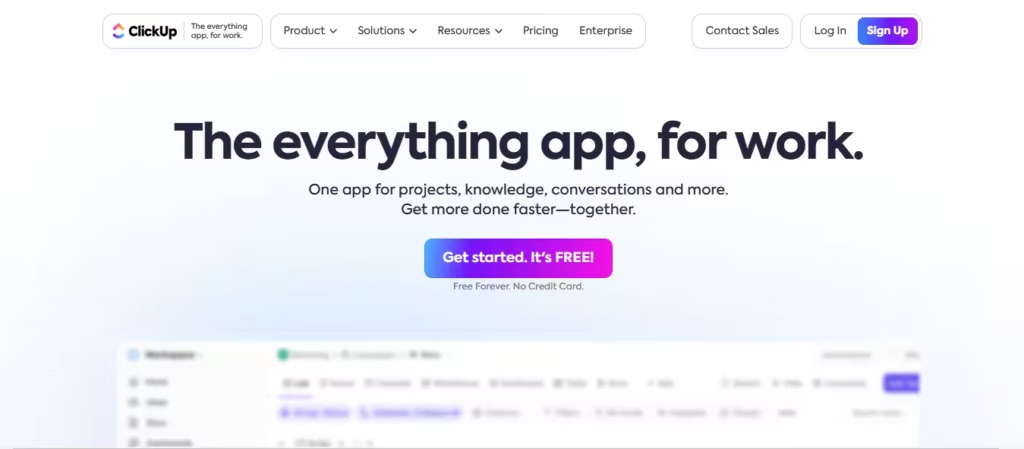
ClickUp offers unlimited user access, tasks, and project management features. It is ideal for tracking job sites through Map View, proofreading, and reviewing documents through ClickUp AI. Project management templates allow for the creation of new documents.
Professionals leverage these templates to automatically calculate material estimates, costs, and inventory as input is provided, leading to escalated workflow. Additionally, this software offers flexible CRM features to manage customer relationships effectively.
Top Features
- This construction ERP software is highly customizable, from project statuses to project categories.
- It is possible to add templates for incorporating architectural design, meeting minutes, client relationship management, and more.
- Easy collaboration from anywhere and manage projects offline.
Limitations
- No table view on mobile app (coming soon).
- People used to more bare-bones ERM systems may find the project management suite overwhelming.
Reviews and Ratings
- G2: 4.7/5 (over 8,566 reviews).
- Capterra 4.7/5 (over 3,775 reviews).
Acumatica
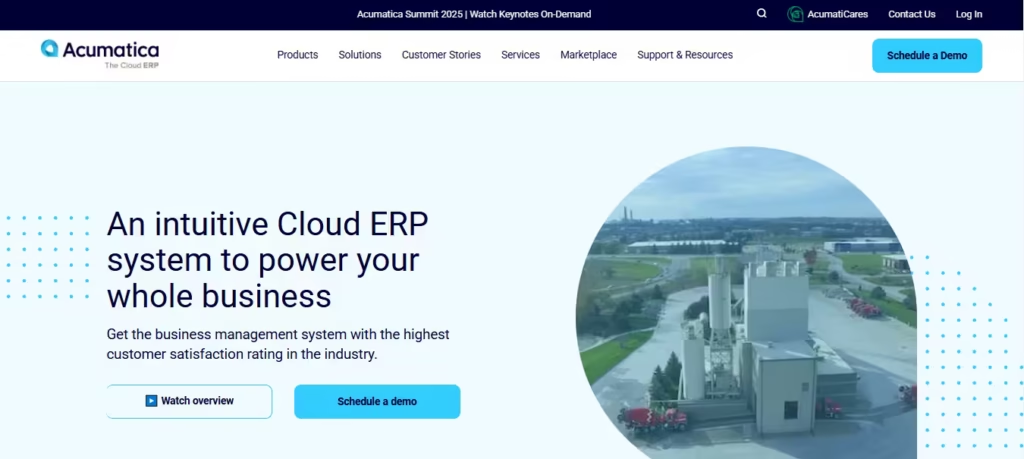
It is a construction ERP software that simplifies construction operations. It provides role-based and real-time dashboards to access data instantly. Acumatica system also possesses machine learning and AI capabilities for processing all the information and offers automatic decision-making based on the findings.
One of the major features of this application is that it bridges the gap between office staff, remote teams, and field workers through enabling real-time connection. It promotes better document management to reduce manual paper management.
Furthermore, it allows unparalleled control and visibility. It is easy to access every project detail on the go through any device.
Top Features
- Can be accessed through any device.
- Scales well to suit the growing size of a business.
- Exceptional finance management capabilities.
Limitations
- One has to provide significant user input to generate crucial data.
- At times, accessing data is not easy due to a lack of reporting features.
Reviews and Ratings
- Capterra: 4.4/5 (over 92 reviews)
- G2: 4.4/5 (over 819 reviews)
SAP Business One Professional
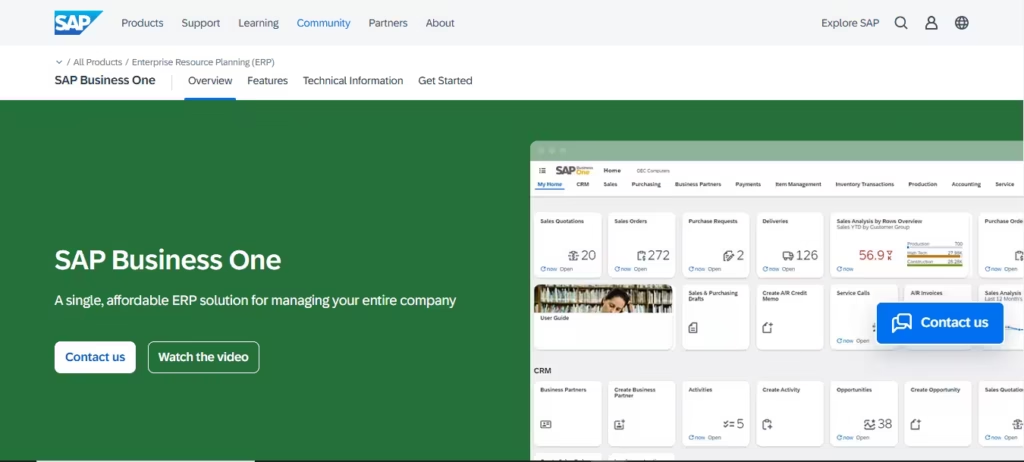
Construction managers harness this application to promote collaboration, mitigate risks, and streamline construction operations. A broad spectrum of features of SAP Business One Professional assist construction firms in efficiently managing their operations, finances, and customer relationships.
This construction ERP software also improves project planning and execution to lower costs and increase margins. SAP is a centralized system that keeps all the team members on the same page and fosters collaboration.
Top Features
- Construction companies can get a reliable and stable environment to work within.
- SAP can be easily connected to a target and receive a live response.
- One-stop solution for all the building needs.
Limitations
- A few users of this construction ERP software complain about the lack of speed.
- A few users would like to have a more intuitive interface.
Reviews and Ratings
- Capterra: 4.3/5 (over 274 reviews)
- G2: 4.6/5 (over 40 reviews)
Procore
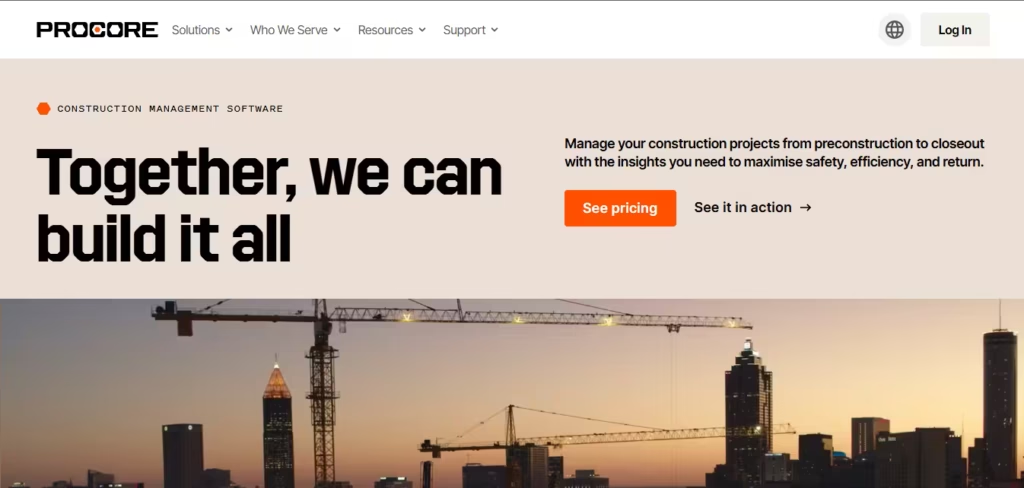
Procore is a leading-edge construction ERP software that helps transform the way construction firms operate. Its advanced scheduling capabilities distinguish it from other ERP systems. This tool can effectively manage complex projects with unforeseen changes and shifting priorities.
Navigating all the changes and monitoring the budget is easy with Procore as it offers excellent document management features and accounting tools. Additionally, advanced chat and videoconferencing tools make collaboration easy.
Top Features
- One of the best customer support.
- Offers onboarding and training (saves training costs).
- Up-to-date overview and access status of all project elements anywhere, anytime.
Limitations
- Developers need to improve bidding tools.
- This tool cannot sync projects manually in real-time.
- Its mobile version does not include some of its company-level information.
Reviews and Ratings
- Capterra: 4.5/5 (over 2,644 reviews)
- G2: 4.6/5 (over 2,000 reviews)
Microsoft Dynamics 365 Business Central
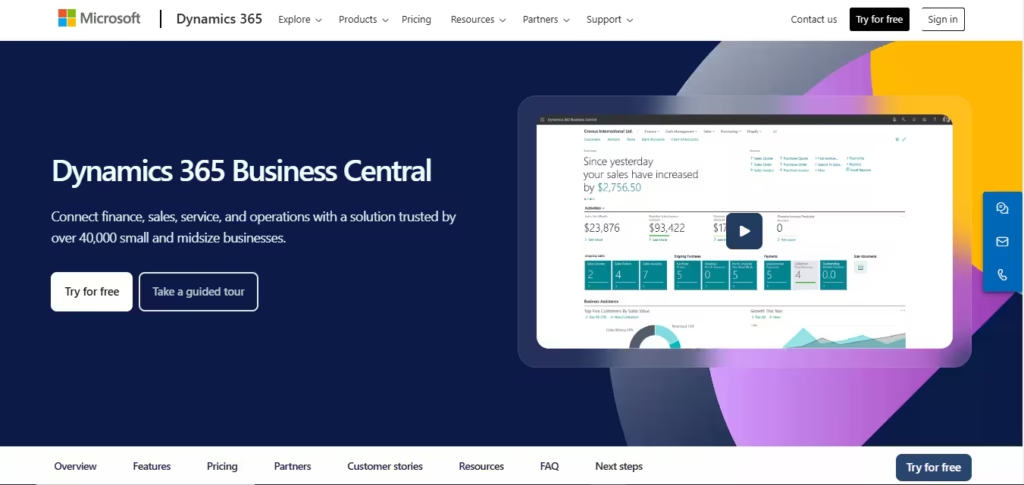
This construction ERP software serves construction companies with bespoke solutions and facilitates forecasting and risk management through AI-driven insights. Microsoft Dynamics 365 Business Central has an interactive dashboard that helps oversee intricate project details and manage leads. An internal compliance-check feature also allows the project to adhere to industry standards.
Top Features
- Offers entry-level ease in inventory management and business processes.
- The developer’s team provides proper assistance with issues.
- This system consists of a variety of tools and functionalities.
Limitations
- Hard to integrate with a few company systems.
- A few people say that mobile apps can be slow and buggy.
- Some companies may not find it ideal for their projects.
Reviews and Ratings
- Capterra: N/A
- G2: 3.8/5 (Over 550 reviews)
Sage
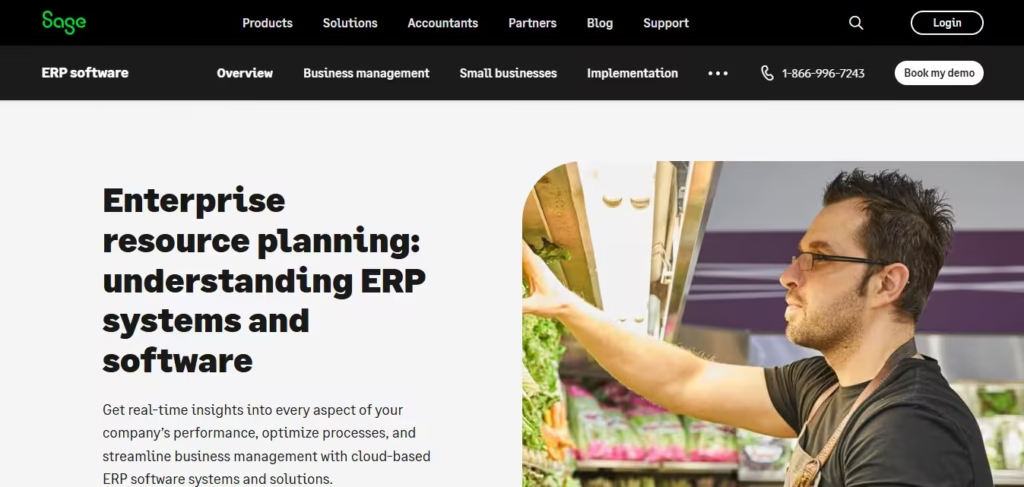
Sage is a construction ERP software that offers comprehensive bespoke solutions to the AEC industry. This tool enables the project stakeholders to track schedules, monitor project costs, and allocate resources.
Additionally, Sage empowers professionals to track inventory levels, material sourcing, supply chain movements, budgeting, payments, and invoices. Sage includes collaboration and document management tools to store contracts, project specifications, architectural drawings, chat, and video calls in the same location. Only people with credentials can access all the information.
Real-time decision-making insights, operational efficiency, streamlined industry compliance, cost savings via automation, and this software’s adaptability to different business needs set it apart from others.
Top Features
- Highly customizable and supports various types of coding.
- The workforce may take a lot of time to master this construction ERP software.
- Its real-time financial management data is impactful.
Limitations
- The mobile app has limited features.
- Some firms may find it expensive.
- May require more time investment due to being unnecessarily complex.
Reviews and Ratings
- Capterra: 4.2/5 (Over 385 reviews)
- G2: 4.3/5 (Over 2,500 reviews)
Oracle Fusion Cloud

Oracle Fusion Cloud is a cutting-edge construction ERP software that drives project profitability and amplifies efficiency. Its user-centric design makes navigating complex tasks easy. The platform is characterized by built-in predictive analytics and provides real-time insights to detect potential challenges early.
Top Features
- Fine location and tracking features.
- Compliant with the spreadsheet.
- Integrates well with other Oracle Fusion tools.
Limitations
- A few users reported it as bulky and slow.
- Modifications are not allowed.
- Setting this up is time-intensive. Small businesses, that juggle different projects, may find it a non-viable option.
Reviews and Ratings
- Capterra: 4.2/5 (Over 53 reviews)
- G2: 4.1/5 (Over 296 reviews)
Penta
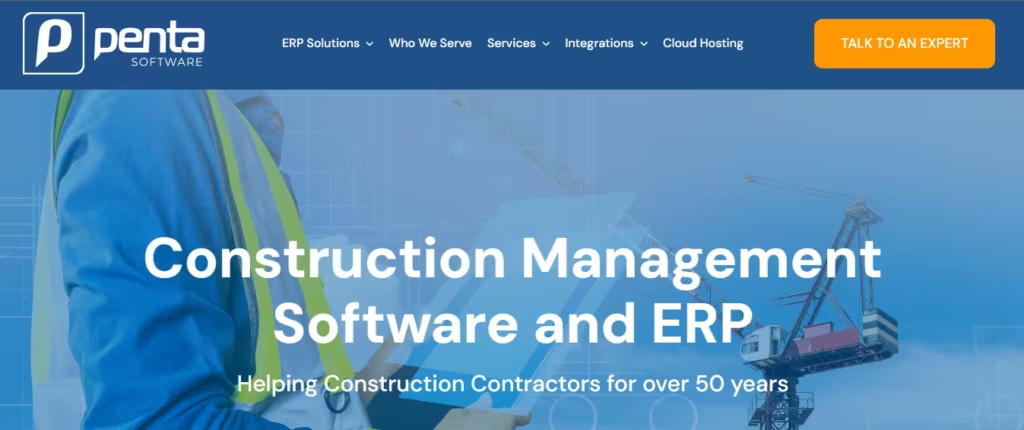
Penta covers various tasks in a construction company, from labor management to actionable analytics. Its mobile version fosters communication and information sharing on the go.
This construction ERP software is a comprehensive solution that offers consolidation and reimagines construction processes.
Top Features
- At times, the latest updates are not available.
- Simplifies the creation of reports.
- Outstanding functional and financial capabilities.
Limitations
- People who are not accustomed to using such software can find it tough.
- A few reviewers reported having issues integrating the software.
- It has a steep learning curve and a few people such as stakeholders may not want to learn it.
Reviews and Ratings
- Capterra: 4.7/5 (Over 32 reviews)
- G2: 3.5/5 (Over 10 reviews)
RedTeam
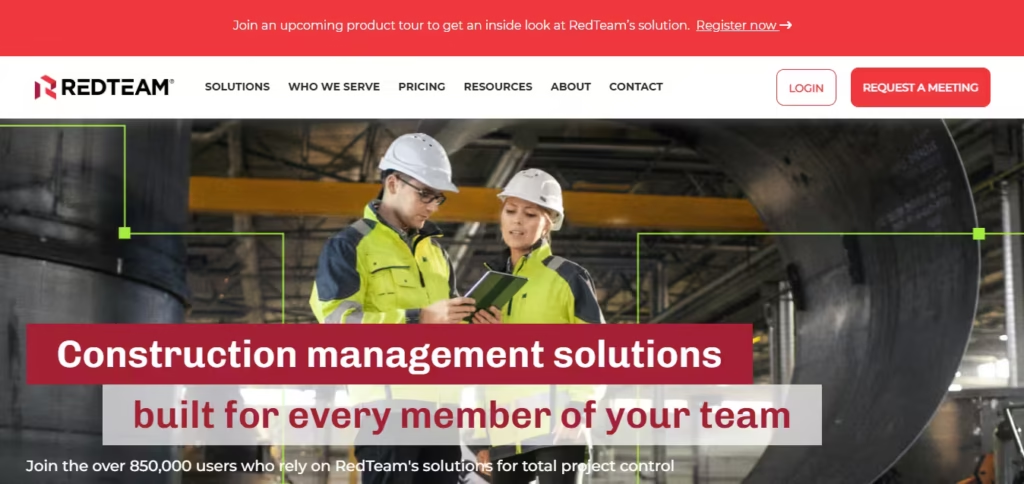
RedTeam has made this list because it has multiple primary construction management functionalities. This construction ERP software offers effective decision-making tools, powered by real-time insights and data.
It is helpful for experienced commercial general contractors or fresher subcontractors as it equips them with high-quality tools and efficiency.
Top Features
- Excellent IT and customer service.
- Streamlines billing process.
- Easy consolidation of various documents for different phases.
Limitations
- Doesn’t work efficiently on iPhones.
- Bugs and flaws occur occasionally, but the developer addresses them.
Reviews and Ratings
- Capterra: 4.3/5 (Over 109 reviews)
- G2: 4.3/5 (Over 82 reviews)
Viewpoint

Viewpoint is a beacon for streamlined construction management in an age where firms rely on collaboration. This construction ERP software includes a communication suite that aids in real-time communication through chat and video and also enables document sharing.
Incorporation of this tool into the operations leads to fewer delays and misunderstandings.
Top Features
- Save drawings, pictures, and documents.
- Project stakeholders have to go through multiple security checks to access data.
- User-friendly accounting functions and data recovery.
Limitations
- Some users request updated functions as some features are missing.
- Collaboration may get difficult as every user requires their own license.
- Less customization.
Reviews and Ratings
- Capterra: 3.9/5 (Over 400 reviews)
- G2: 4.4/5 (Over 11 reviews)
| Also Read: Designing the Future: Best Software for Architects
Final Thoughts
Being in 2025 means the construction industry is transforming and relying more on cutting-edge technology. Construction ERP software can elevate the construction process for large and small firms by assisting in budget control, improving collaboration, and providing real-time updates.
This blog is a complete guide for individuals or companies seeking the same. Hence, choose the right tool considering business size, budget, and project requirements to experience multifold growth and success.
About TechnoStruct Academy
TechnoStruct Academy is the educational arm of TechnoStruct, LLC, a registered design engineering firm based in California. It offers specialized BIM training programs for architecture, MEP, and BIM Management.
Our BIM Certification Courses
BIM-Ready Architecture Advanced
BIM-Ready Complete 2.0 (Michigan State University)








